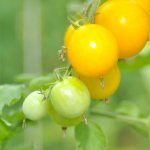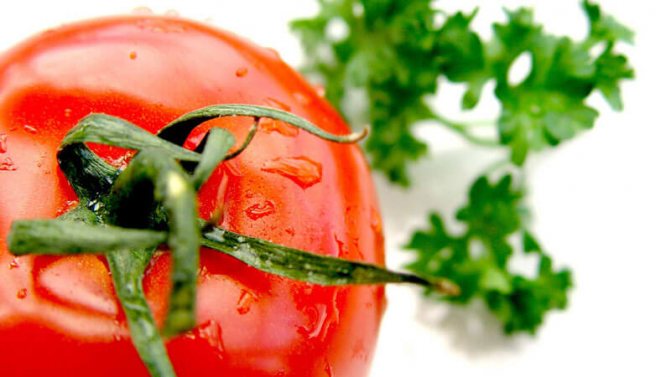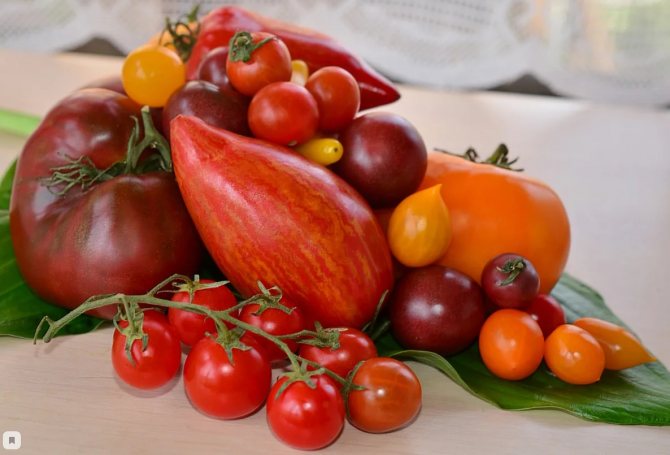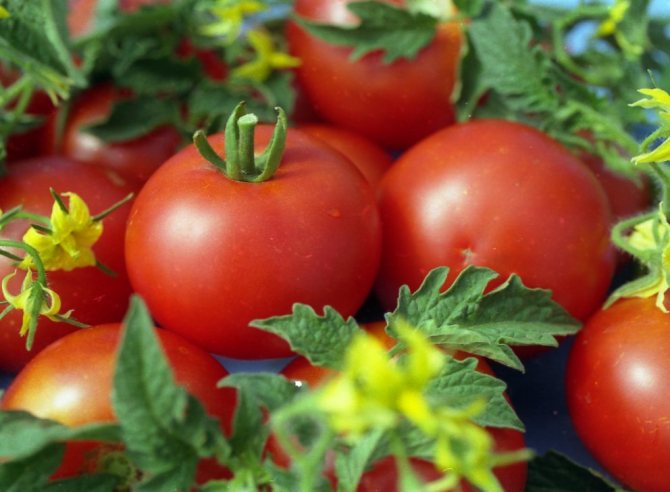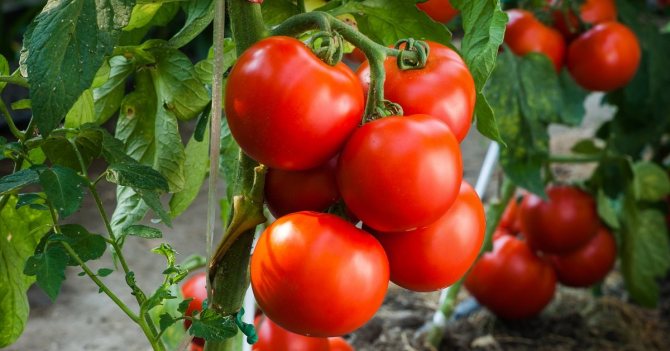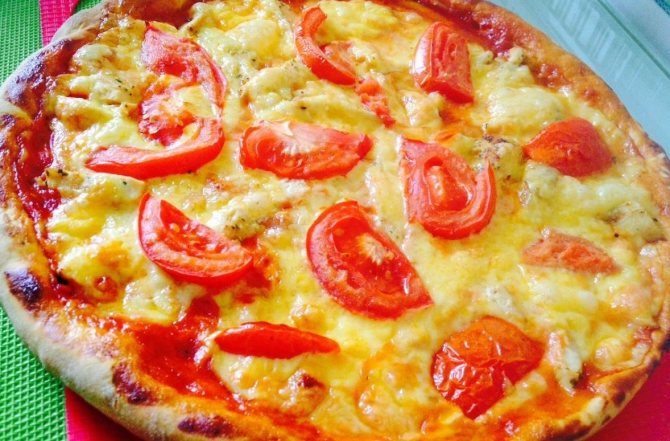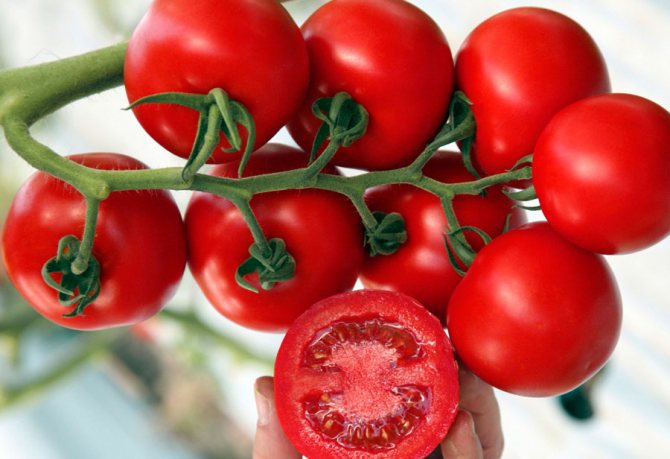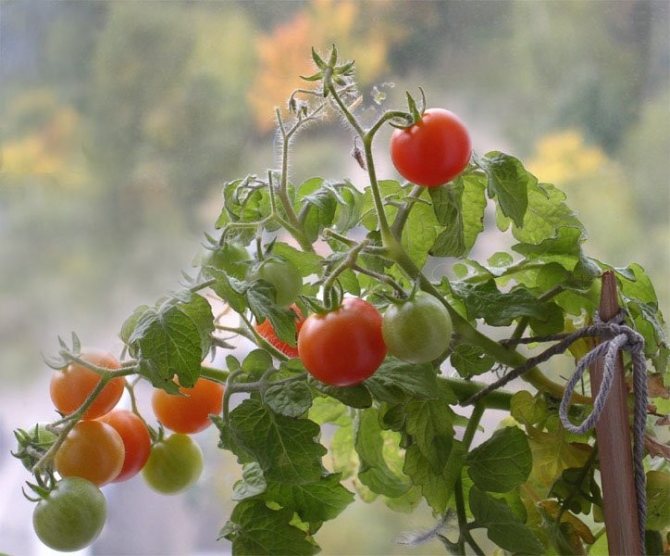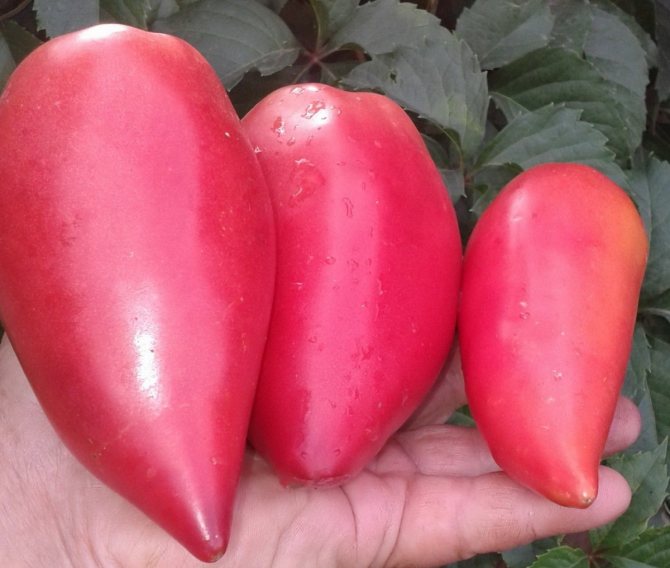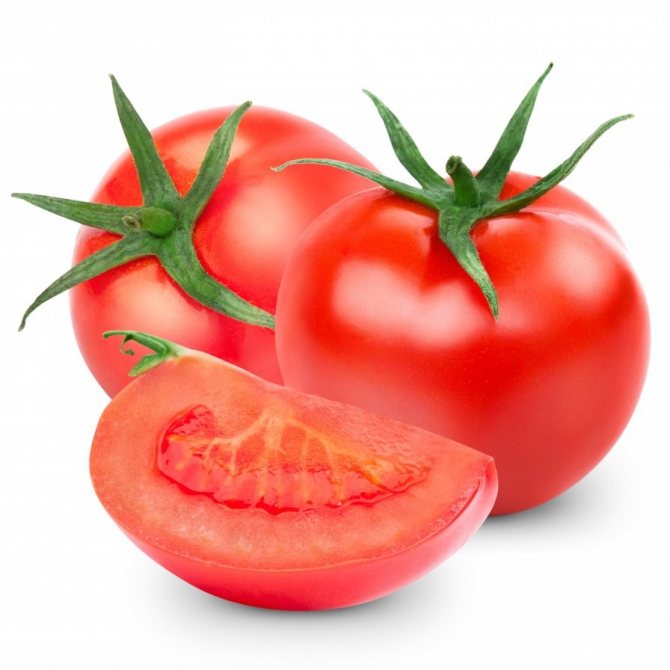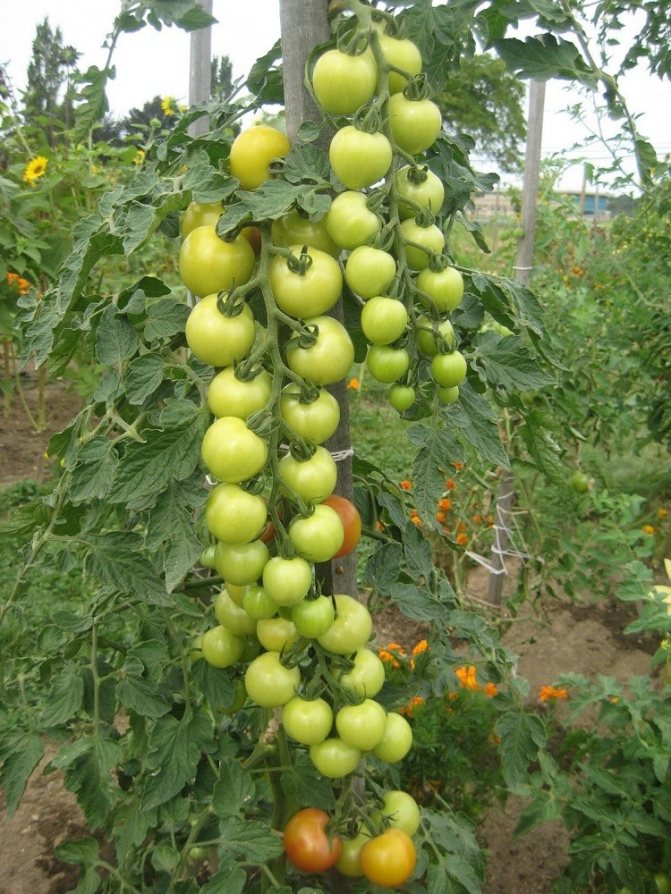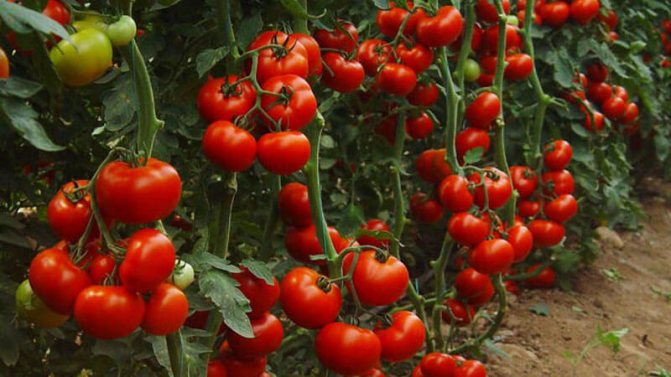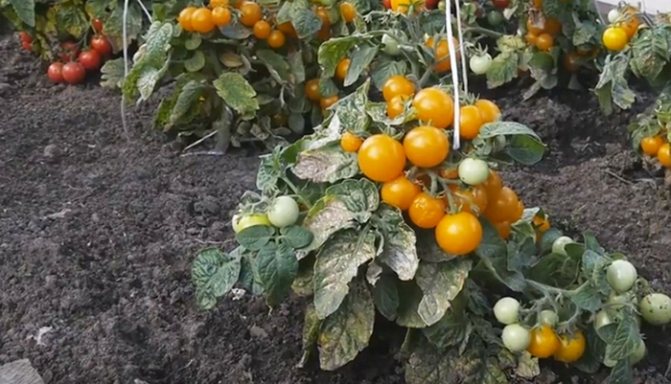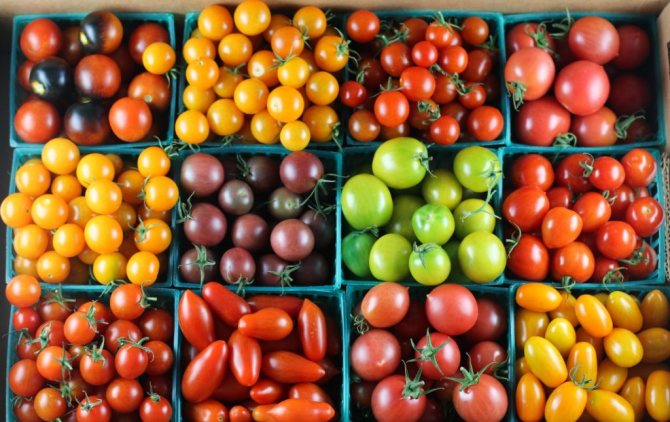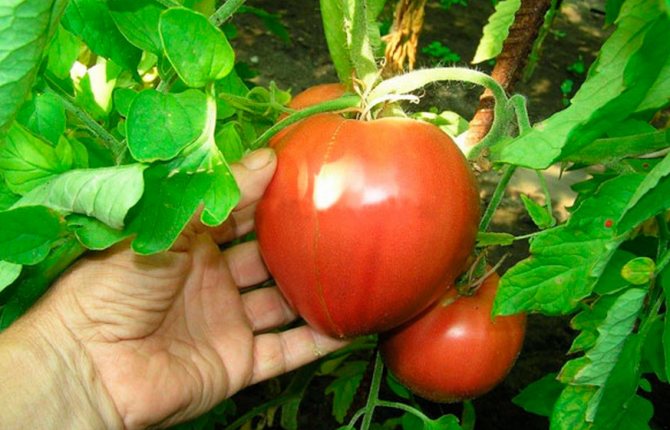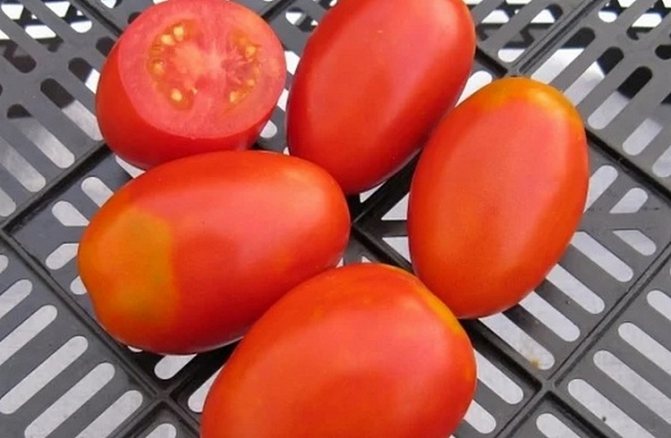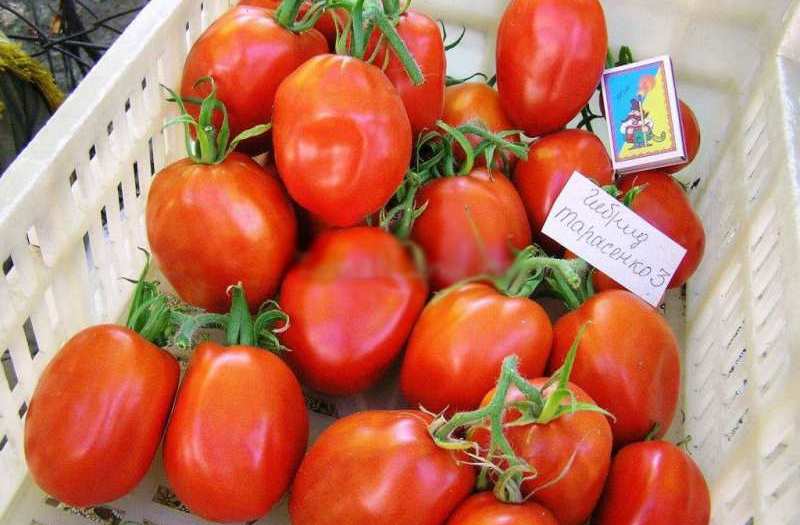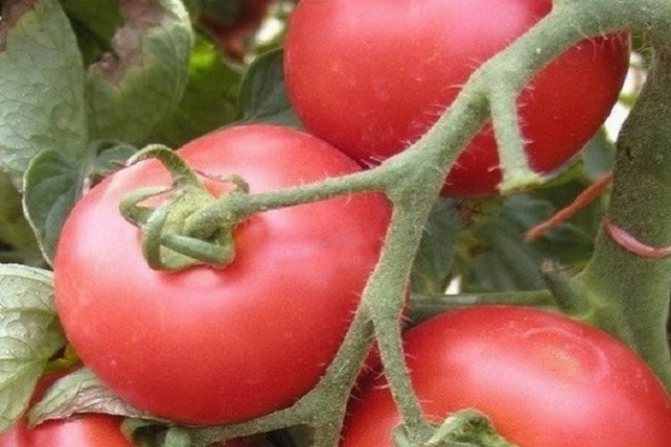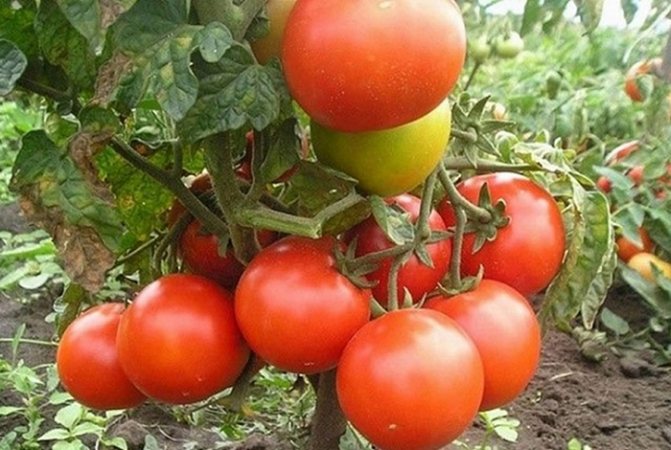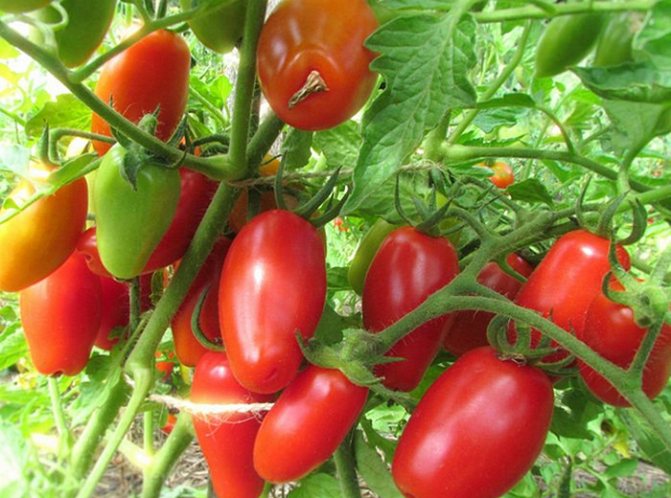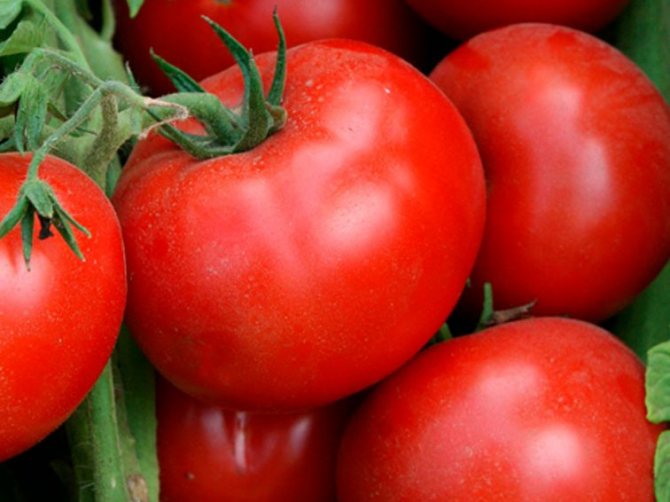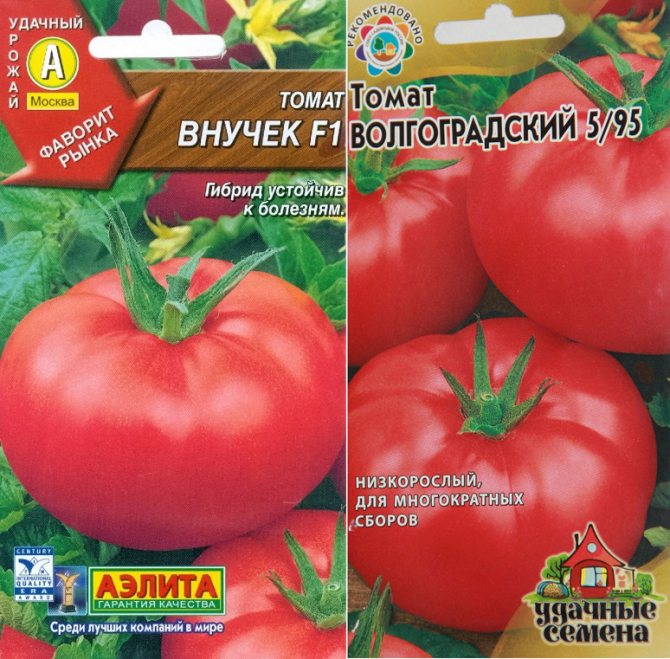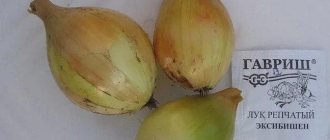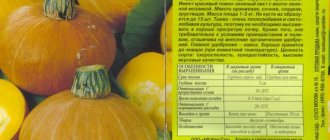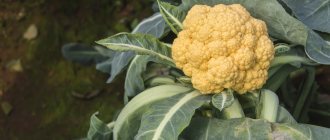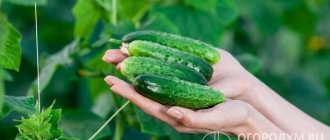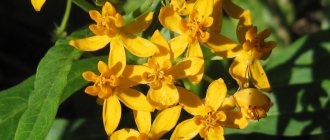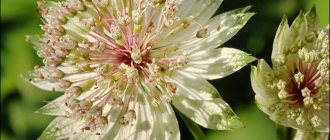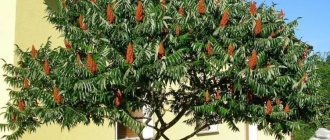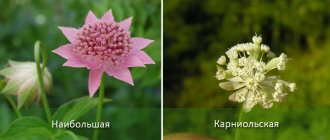Vegetable growing »Tomatoes
2
779
Article rating
The best tomato varieties in 2020 are those that have shown themselves successfully in the previous season or have confidently been in the lead for many years. Thanks to the achievements of breeding, many good varieties and hybrids have appeared. They are chosen according to the climate in the region, ripening period, growing method and depending on the desired characteristics.
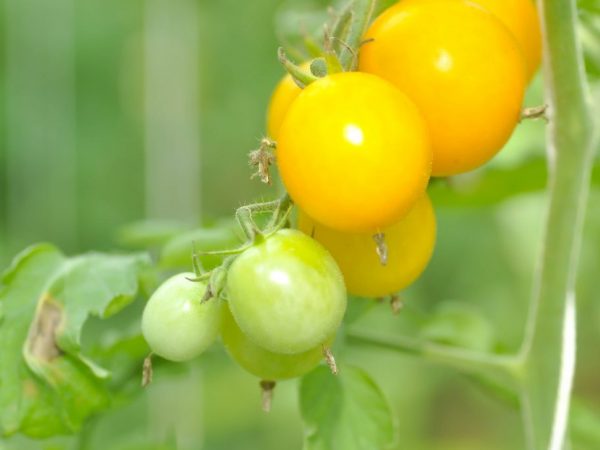
The best tomato varieties for 2020
How to choose
When choosing tomatoes for planting, you need to focus on the climate and weather conditions in the region.
This year, they promise a warm summer, with possible droughts. It is advisable to choose tomatoes with high characteristics of disease resistance and weather changes.
For one plot, it is better to choose several varieties with different ripening periods: early, mid-season and late. So you will provide yourself with a harvest for the entire season.
Check out the descriptions of the different types of seeds and choose suitable tomatoes for fresh consumption, pickling, canning, processing, long-term storage.
Basic requirements for tomatoes for a greenhouse
Often, novice gardeners choose planting material for a beautiful package, without delving into varietal details. But in order to harvest a rich harvest, you need to adhere to certain rules:
- the tomato must correspond to the growing region;
- bring a rich harvest of tasty fruits;
- be resistant to diseases, pests;
- tolerate minor temperature fluctuations.
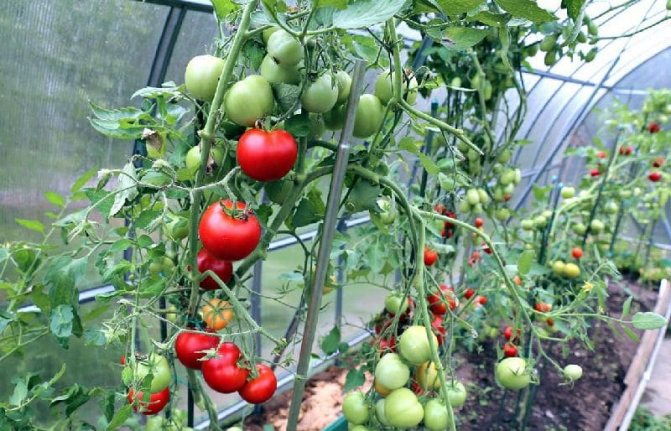

When choosing which species to plant indoors, many prefer tall tomatoes. But so that the harvest can be harvested throughout the warm season, experienced gardeners also recommend planting early and mid-season determinant bushes.
The best of the early maturing
Early ripening of tomatoes is a great advantage, and often a direct necessity.
In the North and in the temperate zone, early ripening varieties are especially popular (after all, only in the south, late tomatoes are guaranteed to have time to ripen). However, such varieties also have disadvantages: they are inferior to mid-ripening ones in yield, and late ones in fruit size.
For open ground
- Maksimka is a versatile low-growing variety with medium-sized fruits (80-110 g), yields a harvest 80 days after germination;
- Alpha - undersized standard tomato with tasty and juicy fruits (60-80 g), ripens 85-90 days after germination;
- Gina is a medium-sized bush with large fruits (200-300 g), yields a harvest 95 days after germination;
- M0ya love (f1) is a determinant plant of medium height (in open ground - 60-80 cm, in greenhouses - 100-130 cm) with elongated fruits (150-200 g), ripens together 85 days after germination.
For greenhouses
- Mandarin is a tall indeterminate tomato with orange fruits of excellent taste (weight - 90-110 g), yields a harvest 90-95 days after germination;
- President (f1) - a popular representative of the Dutch selection with large fruits (180-300 g) and tall bushes, ripens 80-90 days after sowing;
- Superstar - medium-sized greenhouse tomato with large and sweet fruits (weighing 200-300 g), ripens 85 days after germination;
- Garden pearl - a low-growing creeping tomato with a decorative bush and small pink fruits (it can also be grown in a room or on a balcony), ripens 90 days after germination;
- The golden brush is a tall shrub with pear-shaped golden fruits (weighing 20-35 g), yields a harvest 95 days after the shoots appear.
Tomatoes or tomatoes as right. What are the differences between the terms?
Despite the fact that in the old days there were two different names, but they meant absolutely the same fruit, in our time there are differences in these concepts.
"Tomato" is the name of the plant itself, which from the point of view of botany belongs to the Solanaceae family, and "tomato" is the fruit of this plant. As for the origin of these words, it was described above about who and how this plant was called. As you can see, they have different origins.
Yes, and we also share the use of these words, calling tomato juices, pastas, soups, sauces, and tomatoes - what we have prepared, not processed, not processed.
That is, processed fruits are called "tomatoes", and what we grow in the country and cut into a salad is (unprocessed version) "tomatoes".
On various culinary sites, you may notice that instead of the word "tomato" in the recipe for the dish, an ingredient such as "tomato" is indicated.
It cannot be categorically said that the author of the recipe is wrong in this case, since most dictionaries of Russian synonyms indicate that the synonym for the word "tomato" is "tomato" and vice versa.
Although the manufacturers of tomato processed products such as juice, sauce, pasta clearly call them "tomato". Therefore, it should be understood that if a pure tomato is put into a dish, then it should be written as "tomato", not "tomato".
Seed varieties that are grown to produce fruits for industrial technological processing of tomatoes are called "tomatoes". That is, it is correct to say “tomato variety Bella Rosa or Lydia, and not“ tomato variety ”.
Having found out the origin of the words "tomato" and "tomato", we can safely say that many centuries ago the same product was called so.
But time passes, the perception of words is changing (who would say now that the word "tomato" has a foreign origin), many words from the category of "foreign" have become primordially "Russian".
This is what happened with the words that denote culinary terms, the names of products. And, in the end, in the course of all these clarifications, these concepts can be separated.
In order to correctly use the words "tomato" and "tomato", it should be remembered that "tomato" is the name of the fruit of the tomato plant and then, only when it is consumed without technological processing - in its original form, if the product was given such processing and received another product, such as pasta, sauce, juice, then it will already have the name "tomato", but not "tomato".
Watch the purity of your speech, do not make mistakes that can show ignorance or "narrow-mindedness." After all, just using the right words and logically lining up thoughts can make an unforgettable impression on the interlocutor.
The best among the late
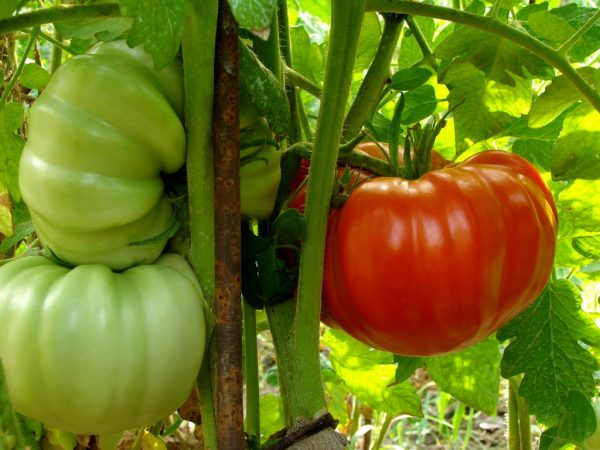

Large and fleshy tomatoes
Late tomatoes are usually cultivated in the southern regions (but when grown in greenhouses, they can be planted in the middle lane).
The fruits are large in size, fleshy pulp and sweet, rich taste. In terms of yield, they are somewhat inferior to mid-season varieties.
De Barao
A popular tall tomato that can be red, pink or orange in fruit.
Tomatoes are medium in size (60-80 g), oval in shape and excellent taste.
They are delicious fresh and are often used for pickling (due to their compactness and strong skin).The fruiting period lasts until the very frost.
Titanium
A low-growing variety for open ground (from 40 to 60 cm). The fruits are raspberry-red in color, weigh about 150 g and have a classic tomato flavor.
Sufficiently dense pulp and strong peel allow you to store the crop for a long time and transport it without problems.
Bull heart
One of the most popular late varieties in the catalog. It belongs to the semi-indeterminate type and is highly resistant to late blight.
Four months after germination, it gives off the harvest. Fruits are fleshy, sweet and large (from 350 to 500 g). Some specimens grow up to 1 kg or more.
Long Keeper
It gets to the top thanks to its amazing keeping quality: tomatoes are stored until March, and sometimes longer.
Bushes are medium-sized (120-150 cm). Fruit weight - from 100 to 170 g, they have dense pulp and skin.
Sourness is present in the taste, inferior to earlier varieties, but quite good in comparison with "winter" tomatoes.
Frost-resistant varieties
According to the description, such tomatoes can be planted in the garden earlier and, accordingly, to achieve an earlier ripening.
- Spiridonovsky is a low early ripening tomato with medium-sized fruits (up to 50 g) of bright red color. Withstands frosts down to -14 °.
- Sibiryak is a mid-season, large red tomato that allows you to get a large number of very tasty fruits.
- Kemerovets is a low-growing variety with pink fruits weighing up to 100 g. The tomato is universal, suitable for any purpose.
- Orenburg is another versatile variety, suitable for both salting and salads. Fruits weighing up to 80-100 g, they grow on a compact bush;
- Lemon is a tall variety with a late ripening period. Tomatoes are small, yellow, like lemons. They grow in large clusters and keep well for quite a long time, which makes them suitable for pickling.
- The giraffe is a tall plant. Tomatoes are oval, yellow, weighing up to 150 g. They can be stored for a very long time, but they are best suited for processing, not for salads.
- Finish - weather-resistant undersized variety with red-orange round tomatoes up to 120 g.
- Long Keeper is an excellent variety with red round fruits weighing up to 200 g. The bush is tall, requires garter and pinching.
- Persimmon - orange tomatoes grow on bushes up to 80 cm high. Fruit weight reaches 350 g, they resemble persimmon in shape.
- Snegerik is a low-growing, unpretentious and frost-resistant tomato. The height of the bush is up to 40 cm, red fruits weigh up to 200 g.
():
Tomato is a tropical plant. No tomato varieties can withstand frosts even down to -1 degrees. At this temperature, they die in a matter of hours. Don't believe the ads. Even cabbage - one of the most cold-resistant crops in an adult state - withstands freezing only up to -8 degrees. At this temperature, her head of cabbage turns into an ice ball, but after defrosting her tissues do not die.
The most exotic


Fancy tomatoes
Tomatoes can be not only tasty, but also decorative. Exotic species look great both on the table and in the garden.
Most importantly, the quirky appearance is combined with good taste and disease resistance. Consider the most popular unusual tomato varieties for 2020.
Blueberry plum
This miracle of selection combines fruits of two colors in one bush - purple and yellow. The tomatoes themselves are small (from 20 to 30 g), look beautiful in long brushes.
The fruits are not only original, but also very tasty: purple - with a blueberry flavor, and yellow ones - sweeter.
Black Pearl
Popular among new products, has small decorative fruits. The bushes reach 1.5-2 meters and grow luxuriantly.
Small tomatoes (up to 30 g) of black color with a pinkish tint ripen on the brushes.
Kesidy's quirk
This American variety was recently considered one of the rare, but today it has gained considerable popularity in Russia.
Tomatoes are adorned with numerous sinuous stripes and have the same sinuous shape. Gardeners note the good taste, keeping quality and versatility of the fruit.
Absinthe
A tall plant with large fruits from 300 g. Its highlight is that ripe fruits still remain green.
The difference between Absinthe and other green counterparts is in its special taste (sweet, but a little spicy). Tomatoes are eaten fresh, they cannot be stored for a long time.
Pink accordion
Differs in unusual ribbed fruits, similar to a rounded accordion.
Tomatoes are large enough - from 200 to 500 g, of a beautiful raspberry-pink color.
The bushes grow up to 2 meters and require a mandatory garter - they are recommended to be planted in a greenhouse.
The best varieties from collectors for 2020
Rare exotic tomatoes can be purchased from select collectors. Introducing the top 10 varieties of 2019
Yielding Guseva - tomatoes with strong, shortened stems and wide leaves, are distinguished by a good harvest: up to 40 kg can be grown per 1 sq. M.
Valery Medvedev's spring round dance is a very early tomato up to 80 cm high, he needs a garter and pinching.
Cherry red - cherry for greenhouses, also from the collector Medvedev, has a high yield and excellent taste. A bush up to 1.8 m high requires a garter, the fruits are excellent for canning.
Collector Valery Popenko has been dealing with tomatoes for over 30 years. His catalog contains more than 500 varieties, something new appears every season. However, Aventunyay is one of the most common: a mid-season tomato grown from Canadian seeds. Fruits weighing up to 400 g, deep red. They are versatile.
Abono - a novelty from Lydia Ganzen became available only in 2019. A tomato with a medium ripening period, high yield, with very tasty large fruits (weight up to 200 g). Originally from Italy.
Shaggy Kate from Lyudmila Kodzasova, a collector from Lithuania, is distinguished by decorative purple tomatoes, with slight pubescence. A relatively low determinant bush requires a garter and pinching. Not the most common variety, but one of the most decorative.
Early watermelon Tamara Yashchenko - has a bush height of up to 1 m and fruits up to 1 kg. An improved early variety with high yield and excellent taste.
Tomato Snow White from collector Lyubov Myazina is an early ripe tomato with small fruits. The bush is low, up to 50 cm, does not require formation, which favorably distinguishes it from other varieties. The fruits are round, weighing no more than 120 g, while they have excellent taste.
Tomato Orange of agricultural firm Gavrish has rounded yellow fruits, reminiscent of oranges. Weight reaches 250 g, tastes sour, does not crack, suitable for both salting and fresh consumption.
African liana is a variety from the collection of Natalia Dryzhakova, which is updated every year. A thin tall bush grows up to 2 m, requires support and donation. The fruit is deep pink in color, heart-shaped and weighs 300 g.
Exotic varieties will decorate your site
Speaking of collectible varieties, one cannot fail to note the Boris Sonin catalog, which contains many excellent varieties and is updated every season. Almost all of them are distinguished by high yield and excellent taste.
Here are the top 10 tomatoes that you should pay attention to if you are interested in a good harvest:
- Apple;
- Cups;
- Bull heart;
- Buffalo heart;
- Bulgarian miracle;
- King of Siberia;
- Pink honey;
- Your Majesty;
- Kiev woman;
- Cow's heart.
The best in yield
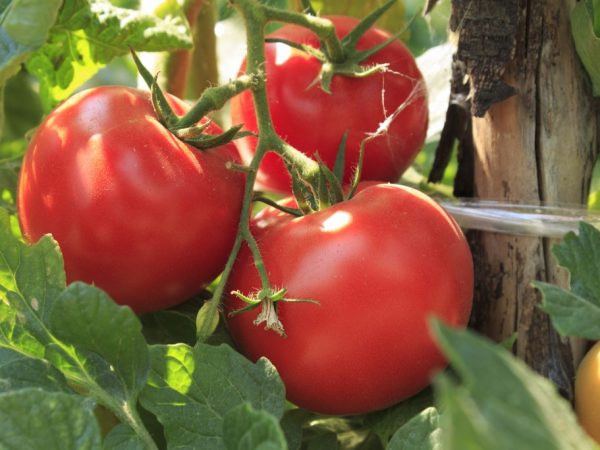

Tomatoes need careful care
The yield of a variety depends on many factors: climatic conditions, growing method, additional fertilizing, formation, etc.
Higher yields are usually obtained from tall bushes, but you also need to take care of them more (tie, shape, feed).
At the end of 2020, gardeners celebrate the following high-yielding varieties, which retain their positions in the new year:
- De Barao - from 8 to 10 kg per bush in the open field and up to 20 kg in the greenhouse;
- Wonder of the world - yields yields of 10-15 kg per bush;
- Orange cream - from 5 to 7 kg from a medium-sized bush;
- Alsou - from 7 to 10 kg per bush;
- Anastasia - about 12 kg from a tall bush;
- Raspberry giant - 10-17 kg of large tomatoes from a bush;
- Riddle - get 20-25 kg from m²;
- Fairy's gift - 8-12 kg / m²
Basic growing tips
Tomatoes from the Siberian collection do not need special care, like other plants, they need to be watered and fertilized in time with mineral compounds. Tall bushes must be tied up, side shoots are pinched so that the bush is formed correctly. As a result, the yield increases significantly. We must not forget to inspect the plant for the presence of pests and diseases, if necessary, take urgent measures. Monitor the condition of the ground, humidity in the greenhouse and pollination of flowers.
Before planting tomatoes of the Siberian collection in open ground, it must be borne in mind that they can grow well and bear fruit if they are well lit and the air temperature is high enough. Most of these varieties do not tolerate even small frosts, when the temperature drops to plus 15 ° C, the tomatoes will stop blooming, and if it drops even lower, then growth will be inhibited.
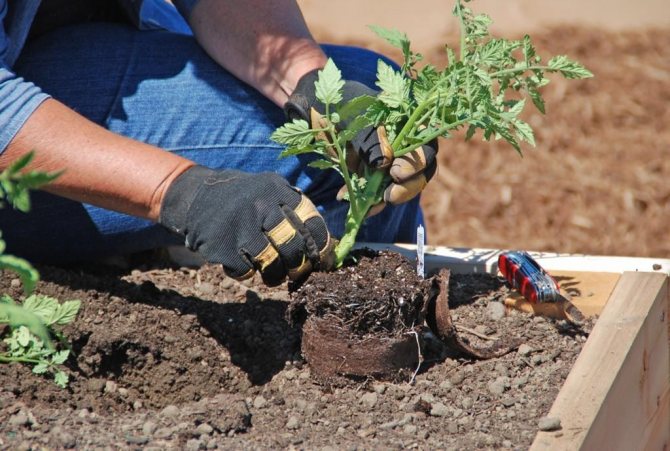

Breeders have bred the newest varieties that are able to withstand cold temperatures from minus 1 ° С-2 ° С. Such persistence is endowed with tomatoes, the seeds and seedlings of which have been hardened. For planting, it is advised to allocate areas with fertile soil. Swampy and saline lands are not suitable. In autumn, the plots are dug to a depth of 25-30 cm, phosphorus and potash fertilizers are applied. In the spring, when holes are made, they are poured into:
- 8 g superphosphate;
- 3 g of potassium salt and ammonium nitrate;
- 500 g of humus.
Seeds collected from ripe tomatoes can be planted next year. The varieties of the Siberian collection in harsh climatic conditions consistently give a good harvest, therefore they are gaining more and more popularity. In addition, all tomatoes have an excellent taste. Before you start sowing, you should see the photo with descriptions. This will help you select suitable varieties for outdoor and greenhouse planting. Each of them is good in its own way.
For open ground
In a vegetable garden without a greenhouse, it is more convenient to grow undersized or medium-sized tomatoes. In the southern regions, tall varieties are also planted, tying the bushes to a trellis.
Tatiana Orlova (Candidate of Agricultural Sciences):
If in the Middle Lane and in the more northern regions of the country, sunlight and heat are not always enough for growing tomatoes in open ground, then in the south there is an excess of sun. When choosing varieties in this region, preference is given to varieties with the following characteristics: they form a powerful leaf apparatus, well cover the fruits from the sun, and are drought-resistant.
The best tomato varieties for 2020 must be resistant to weather changes, cold weather and pests.
Iceberg
Low-growing bushes reach 70 cm, fruits are medium or large (from 150 to 250 g).
Tomatoes ripen early and yield bountiful harvests even during the cold rainy season. The fruits have a classic taste, suitable for salads and canning.
In the top ten
The size of the bushes is from 50 to 70 cm, the weight of the fruits is from 100 to 200 g. Tomatoes are yellow, round and sweet.
Differs in an early ripening period, is not afraid of cold weather (suitable for the middle zone, the Urals, Siberia).
Cheerful gnome
On a sprawling bush 40-50 cm high, oblong red fruits ripen abundantly.The weight of tomatoes is 70-90 g.
Ripening period - early, disease resistance - high. Compact fruits are well suited for salads and winter preparations.
Danko
Open field bushes grow up to 60 cm. Fruits are heart-shaped, large, of classic taste. The weight of tomatoes is from 150 to 400 g. The tomato is resistant to drought and pests.
Gourmet
The height of the bushes is 50-60 cm, the fruits are medium-sized (100-150 g), round, crimson. Tomatoes are sweet and juicy, universal consumption. Ripening - earlier and amicable. Grow well even in cold or dry seasons.
Features of Siberian selection
All varieties of Siberian tomatoes grow well and develop in areas where the climate is rather cold and the summer period is short. They are grown by seedlings. They stand out:
- resistance to moisture, cold and most diseases;
- shade tolerance;
- balanced taste;
- short ripening period.
Experienced gardeners in tall and large greenhouses recommend growing indeterminate varieties, they grow in height over 1.5 m. In small greenhouses, preference should be given to determinant tomatoes. The latter have low and compact bushes, and as for indeterminate ones, about 12 kg of vegetables can be harvested from each bush.
For greenhouses
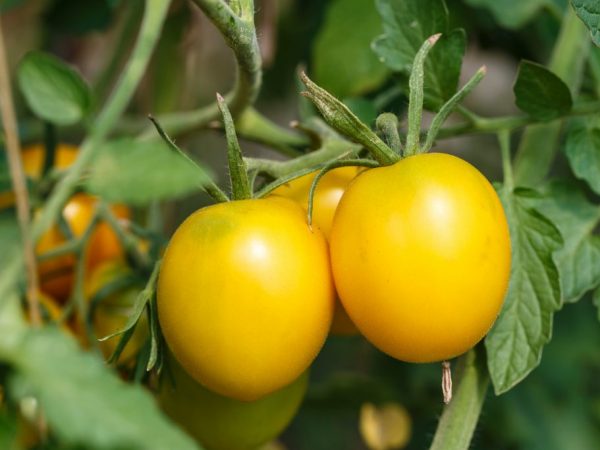

Tomatoes should be tied
In greenhouses, seedlings of tall indeterminate tomatoes (often hybrids) are usually planted.
They need mandatory tying - to a trellis or garden net. In addition, tall bushes require the formation of more frequent fertilizing, but their yield is much higher.
Tatiana Orlova (Candidate of Agricultural Sciences):
The yield of indeterminate varieties is higher due to the extended growing period. They do not "perch" like determinant (bush) tomatoes, but have unlimited growth in height, forming more and more new inflorescences.
Alice
A tall American variety with bright, heart-shaped fruits. Tomatoes are distinguished by excellent taste, juicy and fleshy pulp.
Fruit weight - from 300 to 600 g, and sometimes more. Productivity - 6-8 kg per bush.
A barrel of honey
Large-fruited tomato of medium ripening. Tomatoes weight - 300-400 g, color - yellow or orange.
The main advantage is the amazingly sweet taste of the fruit. The bushes are usually 2-stemmed and fed every two weeks.
Cherry
Shrub - carpal type, tall, early ripening. Up to 50 small tomatoes ripen on each brush. Fruit weight - 10-15 g.
The taste of tomatoes is sweet, fruity. The bushes look decorative and bear fruit for a long time.
Pink fig
Tall bush with original ribbed fruits. Tomatoes are raspberry-colored, very sweet, large (from 200 to 500 g). Sometimes there are voids in the fruits.
The tomato is resistant to diseases and adequately tolerates weather changes.
Classification, pros and cons of various greenhouse tomatoes
Growing tomatoes under a film cover has its own strengths and weaknesses. When grown in a greenhouse, you can get an early, maximum yield. The disadvantages include high temperature and humidity, poor air circulation and lack of taste.
Early
Early varieties are suitable for sowing in regions with unfavorable climates. The initial harvest is removed 3 months after germination. This group may include low standard tomatoes and medium-sized determinant varieties. Early-ripening tomatoes have pros and cons. If you grow early varieties, then you can begin to remove the fruits in mid-June and avoid infection of the bush with late blight. The disadvantages include a short daylight hours. Lack of lighting affects the palatability of the fruits, they grow less juicy and aromatic.
The most popular early maturing varieties:
- Alliance;
- Verliok;
- Yvette;
- Sweet bunch;
- Hurricane.
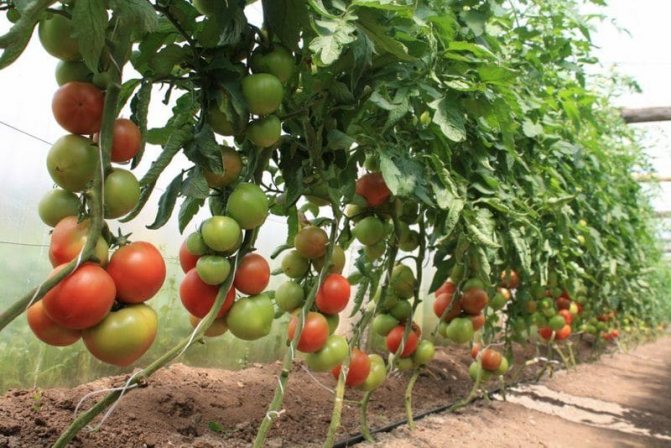

The most productive
To harvest a record harvest of greenhouse tomatoes, you need to choose a variety wisely. For this, hybrids that meet the following indicators are suitable:
- high fruiting;
- fast ripening period;
- good taste;
- disease resistance;
- continuous formation of flower brushes.
Expert opinion
Stanislav Pavlovich
Gardener with 17 years of experience and our expert
Ask a Question
It is impossible to grow late-ripening varieties in a greenhouse, since the growing season occurs at the time of the development of infections and if the agrotechnical rules are not followed, the desired harvest may not be obtained.
Highest-yielding tomatoes:
- Pink raisins;
- Miracle of the earth;
- Nobleman;
- Blagovest F1;
- Indio F
Undersized
Often novice gardeners choose undersized varieties. Since they are unpretentious, they do not need support and they do not have stepchildren. Positive qualities of planting low bushes:
- small growth, bush height 30-50 cm;
- high productivity;
- the bush is small, low-leafed;
- friendly ripening of fruits;
- tomatoes of the same size;
- cold-resistant, withstand a sharp change in air temperature.
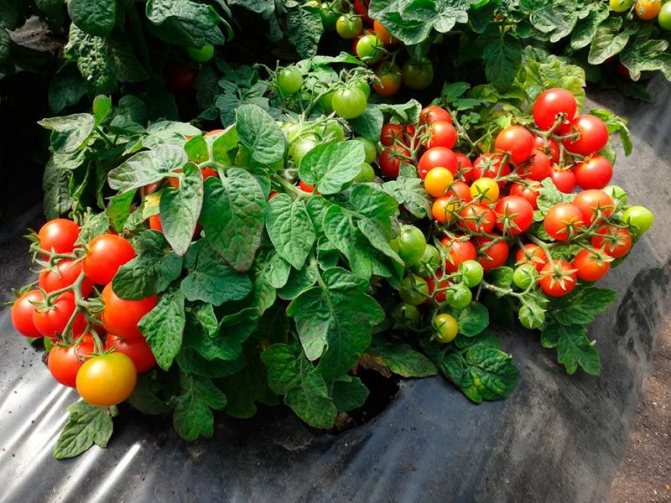

Experienced gardeners often refuse undersized varieties. Since the bush forms only 2-3 brushes on each shoot and fruiting ends quickly. These varieties are suitable for those who want to get an early harvest without much effort.
Important! All short species love close proximity.
Common tomatoes:
- Tanya F1;
- Junior F1;
- Alsou;
- Torbay;
- Beta.
Large-fruited
Large varieties of tomatoes require more careful maintenance. Seedlings are placed at a distance of half a meter from each other, stepchildren are regularly removed, when 4–5 leaves appear, the plant is tied to a support. Large-fruited tomatoes have a fleshy, juicy pulp and weigh more than 200 g. They have a good taste and are suitable for vegetable salads, sauces, adjika and juices.
Despite the large number of advantages, large-fruited species have disadvantages:
- ripen later than small-fruited;
- demanding care;
- support is needed;
- the crop is not suitable for whole canning.
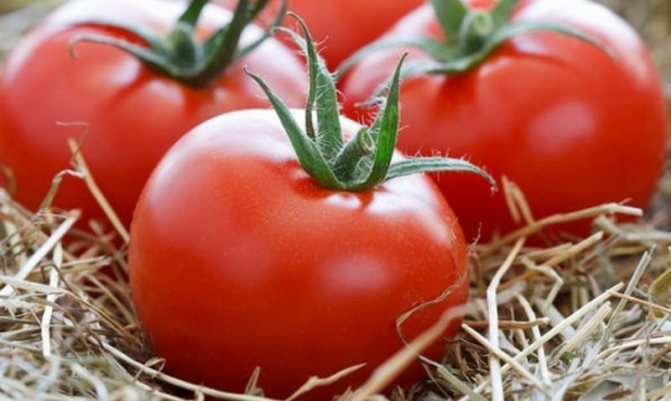

The most popular varieties and hybrids:
- King;
- Rosmax F1;
- Abakan pink;
- Mikado;
- Stellate sturgeon.
Resistant to late blight
Phytophthora is a dangerous infectious disease that appears on stems, leaves and fruits. At the initial stage of infection, the stem of the tomato bush is covered with brown spots of irregular shape. Without treatment, the inflorescences darken and fall off, and after black spots appear on the leaf plate, they curl and dry out. If an infection has struck the bush during fruiting, the tomatoes become covered with black spots, not having time to ripen.
Before starting treatment, you must first identify the cause of the onset of the disease. Late blight appears on tomatoes for some reason:
- thickened fit;
- jumps in night and day temperature;
- excessive irrigation during fruiting;
- excess nitrogen in the soil.
In order not to be left without a crop, you need to choose the right varieties. According to gardeners' reviews, they are resistant to late blight:
- Budenovka:
- Gilgal F1;
- Fantasio F1;
- Laurel F1;
- Fenda
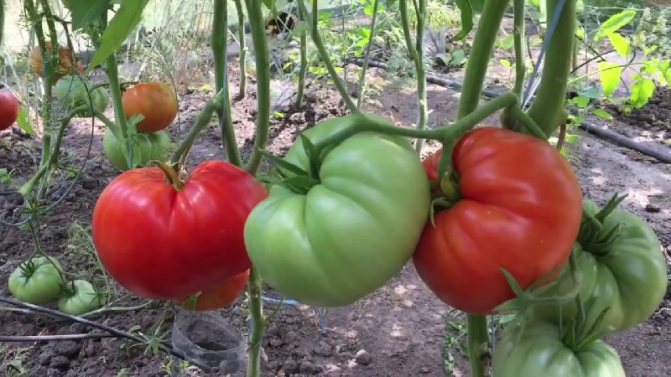

Cherry
Small-fruited tomatoes - cherry, contain a large amount of dry nutrients and sugar, so cherry is perceived as a fruit and not as a vegetable. These tomatoes can be:
- Determinant - the bush reaches a height of 1 meter, the mass of fruits is 7-10 g.
- Semi-determinant - the plant reaches up to 1.5 m in height, tomatoes weighing no more than 25 g.
- Indeterminate - a tall plant reaches up to 3 m, fruit weight 25-30 g.
See also Tomato variety Intuition: yield and cultivation features
In biological maturity, tomatoes do not crack; depending on the variety, the peel can be colored red, yellow, green. On the bush, the crop is located in separate fruits, bunches, brushes. In shape, they can be round, pear-shaped, plum-shaped.
Important! Thanks to the work of scientists, tomatoes have a raspberry, blueberry, strawberry flavor.
Commonly used varieties and hybrids:
- Tiny little havroshechka F1;
- Octopus;
- Tolstoy;
- Olya;
- Palenque F1.
Determinant
Determinant varieties are small bushes up to a meter in height. The plant forms 4–8 flower clusters and stops growing. Determinant tomatoes - mid-season, from seed germination to harvesting 100–120 days. For a bountiful harvest, the bushes are grown in 2 trunks, the rest of the stepsons must be removed. So that the bush does not break from the weight of the fruit, a support is installed next to it.
High-yielding, determinant species:
- Donut;
- Spring of the North;
- Big mommy;
- Three sisters;
- Chernomor;
- Pink honey.
Liana
Liana tall varieties are the most productive tomatoes for growing in tall greenhouses. To obtain a generous harvest per sq. m planted no more than 3 plants. Since several fruits are formed on one brush, it is necessary to tie the bush to a support. To redirect nutrients to ripen the fruit, pinch the top at a certain height.
The most popular types:
- Mandarin duck;
- Aston;
- Shannon;
- Sprinter.
Dutch
Dutch varieties are beginning to gain popularity among Russian gardeners. Since tomatoes are resistant to diseases, have a different ripening period, they are well transported, have a long shelf life, a varied shape and color. But before purchasing seeds, you need to carefully read the description of the variety and the reviews of gardeners.
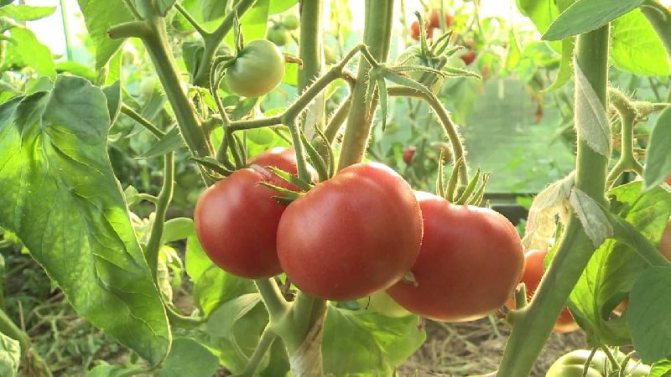

Tomatoes are often grown such as:
- Canna;
- San Marzano;
- Melody;
- Zhenaros.
Late
Late-ripening tomatoes are varieties that ripen 120-150 days after seed germination. Therefore, they are recommended to be grown in regions with long, warm summers or in heated greenhouses. As a rule, late-ripening tomatoes belong to indeterminate varieties, the height of the bushes can reach up to 4 m.
Important! Late varieties gradually yield their crops and have a long growing season.
Review of late tomatoes:
- Wonder of the World;
- Cosmonaut Volkov;
- De Barao;
- Bull heart;
- Titanium;
- American ribbed.
Plum
Plum tomatoes are very popular with gardeners. Since the fruits have a dense, fleshy pulp, with a pleasant taste and aroma. The harvested crop is ideal for sauces, adjika, whole preservation for the winter.
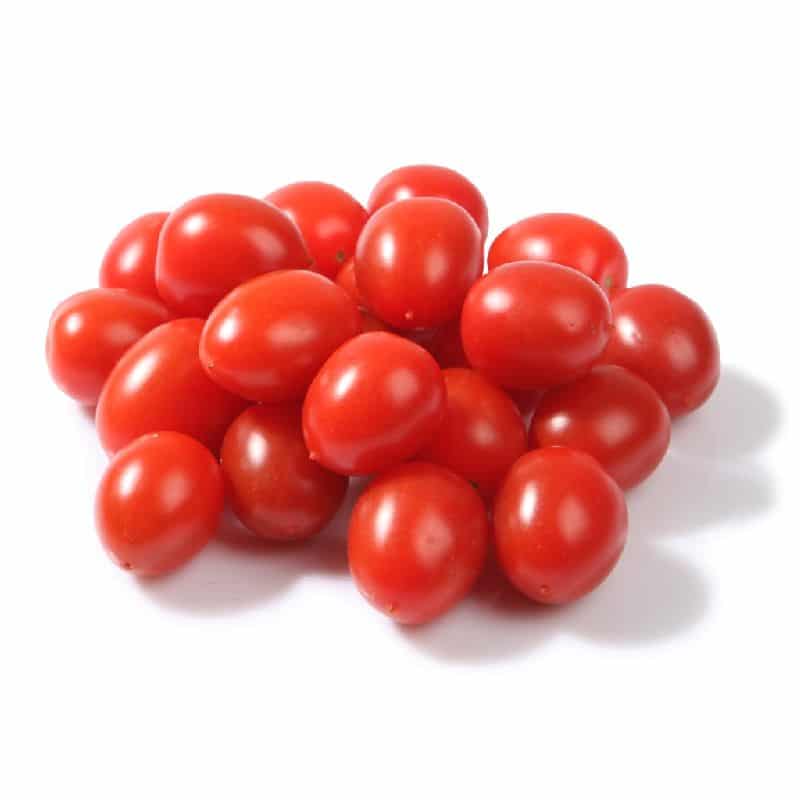

Tomatoes got their name because of their oblong shape. Cream can have different ripening periods, pulp color and bush size. The mass of plum tomatoes ranges from 50 to 120 g. Due to the low moisture content in the pulp, the crop does not crack and has a long shelf life. Due to their positive qualities and unpretentious care, plum varieties are often grown on an industrial scale.
Unpretentious views with great taste:
- Maryushka;
- Watercolor;
- Pink raisins;
- Orange cream;
- Chanterelles.
Medium-sized
If the greenhouse does not allow growing tall varieties of tomatoes, then medium-sized ones come to the rescue. The bush is compact, reaches 150–180 cm. Medium-sized tomatoes can vary in color, shape, ripening and yield.
The most popular are:
- Adam's apple;
- Orange pet;
- Andreevsky surprise;
- Three fat men.
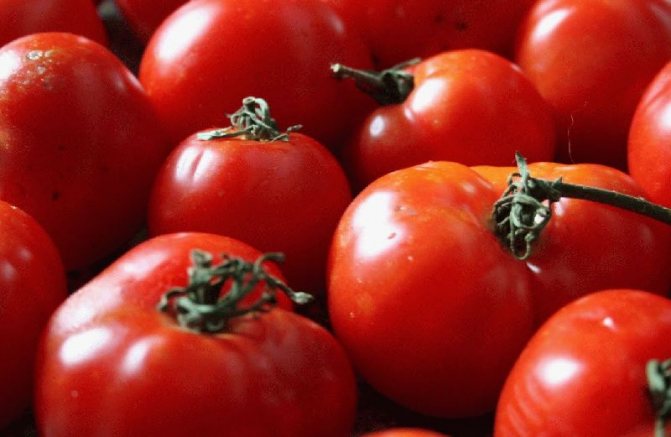

Important! When choosing a variety of tomatoes, you need to carefully read the description, view photos and find out the reviews of gardeners.
For different regions
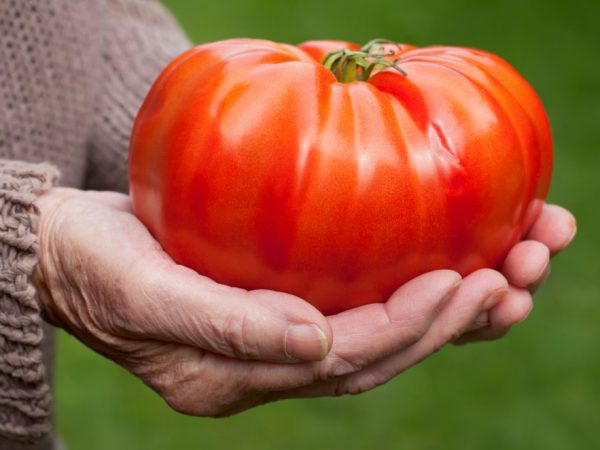

Tomatoes are grown in greenhouses or greenhouses
On the territory of the Moscow region, it is better to plant tomatoes that are resistant to weather changes. De Barao, Sanka, Mongolian dwarf, Andromeda, Cheerful gnome grow well here.
When growing without a greenhouse, it is recommended to use a film.
In the Urals, early standard tomatoes are planted in the open ground: King of Siberia, Iceberg, Alyonushka, Boni-MM.
In greenhouses in the Urals and Siberia, they grow well: Beautiful Lady, Sugar Bison, Siberian Troika, Siberian Trump.Specially bred frost-resistant hybrids are very popular here: Ural, Intuition, Niagara, Kaspar.
Tomatoes are grown in the middle lane, focusing on the characteristics of the variety:
- early and undersized - in the open field;
- tall and late - in greenhouses.
In the conditions of the north-west (in the Leningrad region), for open ground, the Northern Beauty, Fox, Yablonka, and the hybrid Mithridat are recommended.
In greenhouses they grow Leningrad Autumn, Grandee, Yantarny, Mishka in the North.
Regional features of choice
It is very important to choose tomatoes that are suitable for the climatic conditions. There are cold-resistant varieties intended for regions with a changing climate, early-ripening varieties that ripen 100 days after sowing seeds, mid- and late-ripening.
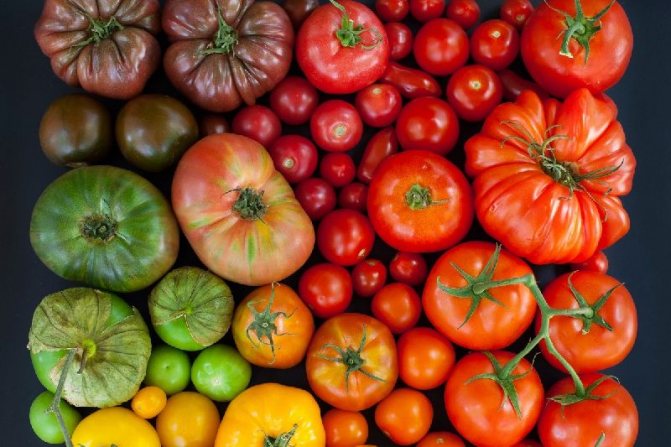

Moscow suburbs
To grow a rich harvest, the planting material must be zoned for the Moscow region. They should be early to medium ripening and high yielding. Experts recommend:
- Explosion;
- Sweet bunch;
- Cardinal.
For Siberia
The planting material must be resistant to sudden cold snaps and short summers. Early maturing, resistant varieties are selected for cultivation, such as:
- King of Siberia;
- Alsou;
- Grandma's secret.
For the Urals
When choosing planting material, you need to focus on varieties that are rarely exposed to diseases and sudden changes in temperature and humidity. The most popular are:
- Pink honey;
- Light;
- Gold fish.
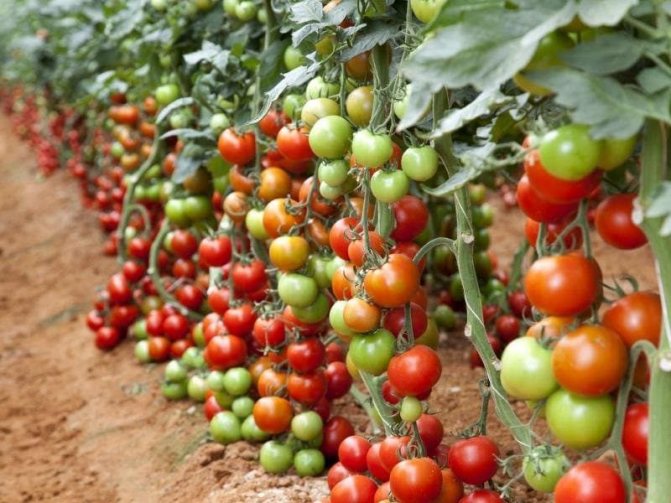

For the Leningrad region
The weather in the Leningrad Region is often changeable. To grow a rich harvest, you need to choose the right varieties for planting. Experts advise:
- Ural multiparous;
- Leningrad autumn;
- Titanic.
Belarus
A correctly chosen variety is the key to a generous harvest. Since the temperature in the country is comfortable, you can drop off:
- Start;
- White filling;
- Baby.
Important! These varieties are most often used by Belarusian gardeners.
Kazakhstan
In Kazakhstan, due to the good climatic conditions, any type of tomato can be grown. When choosing planting material, gardeners stop at large-fruited, high-yielding varieties. Most popular:
- Rapunzel;
- Manon;
- Gilgal.
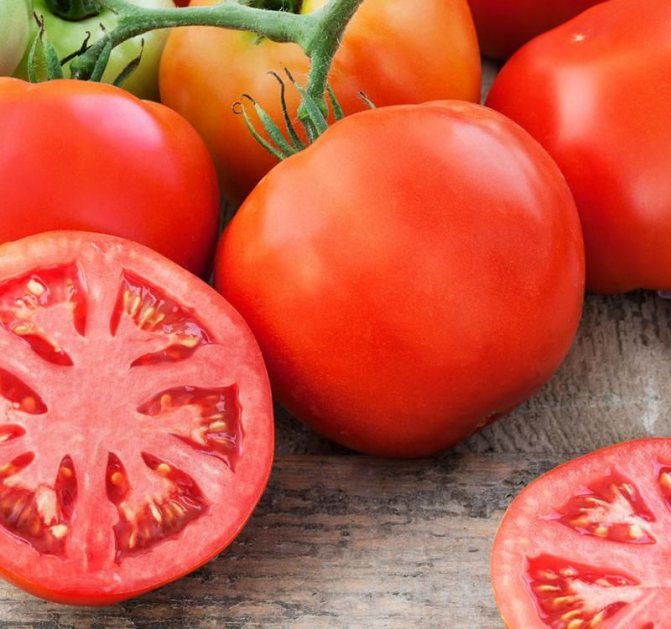

Collectible
You can buy seeds for planting not only from agricultural firms, but also from private collectors.
Often in such collections you can find many interesting varieties, foreign novelties, rare seeds.
Responsible collectors check the offered varieties and hybrids personally, provide descriptions, photos and reviews.
From Popenko
Vladimir Dmitrievich Popenko offers the following tall varieties for 2020: large-fruited Aventunei of Canadian selection, mid-season American elongated, yellow Pineapple pig, Portuguese Dakota and Santa Cruz.
Among the determinants: the universal Rose of the Winds, the yellow-fruited Taxi, the striped Cherokee and the Early Divo. From cherry: dark blue Helsing, sweet Blush and one of the novelties - Cafe Bule.
From Hansen
Lydia Ganzen recommends for growing in 2020 an unusual tomato Strawberry Wedge (a variety of the old American selection, but new for Russia).
From the Italian novelties: large-fruited Abano, pear-shaped Canestrino, heart-shaped Cardio.
From French breeders - St André Coast, from New Zealand - Earl of Edgecomb, from Canada - Early Detroit.
From Kodzasova
In the collection of Lyudmila Kodzasova there is a rich selection of tomatoes of the Gnome subspecies: Grasshopper, Festival, Shadowboxing, Damascus Steel, Tasmanian chocolate, Pete Viper.
She proposes to grow bright and beautiful bicolors in 2020: Bella, Pineapple, Alyonushka, Grapefruit, Gold Medal, Star of Texas.
In her selection of cherry tomatoes: Rapunzel, Pomegranate Drop, Ildi, Blue Keys, Golden Quartz.
From Medvedev
The family contract of Valery Medvedev offers seeds of the following greenhouse varieties for 2020: sweet orange Persimmon, large-fruited - Melon of the North and Giant of the Moscow Region, oblong Aurica, universal Apple Spas.
From unusual greenhouse tomatoes: Yellow Caramel, Golden Canary, Evita, Blue, Chocolate Girl.
For open ground: Spring round dance, Budenovka, Mongolian dwarf, Family, Banana legs.
From Yashchenko
Tamara Yashchenko offers large-fruited tomatoes: Altai liana, Yellow scallops, Zdorovyak, Ivan Tsarevich, King Kong.
Of the high-yielding varieties - Apparently-Invisibly, Vasya-Vasilek, Good fellow, Inna, Kolkhoz Queen.
Collector's Recommendation for 2020 - Strawberry Tree (decorative, delicious and high yielding tomato).
From Gusev
In the collection of Dmitry Gusev, among the most promising red tomatoes: Heart of Tibet, Etalon, Geranium Kiss, Jersey Devil.
In the selection of yellow-fruited: Count Orlov, Orange strawberry, Wonder of the world, Cherry plum, Golden dawn.
Some of the best purple tomatoes include Blue Gold, Blueberry, Dark Galaxy, Blob, Wild Cherry, Amethyst, and Blue Chocolate.
From Dryzhakova
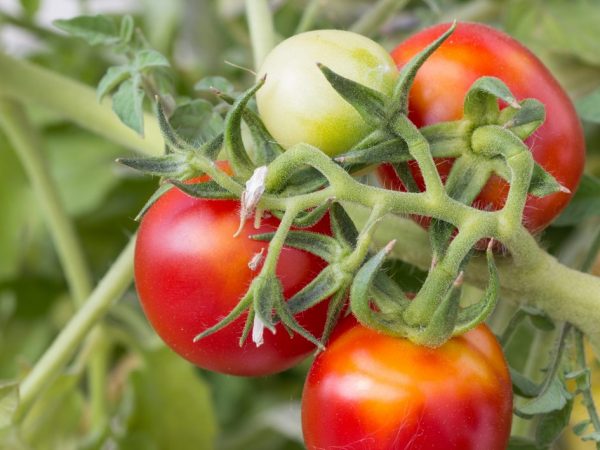

Each variety has its own advantages
Natalia Dryzhakova's selection contains many original striped tomatoes: Queen Anna, Summer of Love, Romantic Breakfast, Bella, Hong Tsai Bao.
From large-fruited tomatoes: Jazz, Clara, Pink Tiger of Siberia, Versailles, Babushkina's joy.
With elongated fruits: Pepper, French cluster, Pink flamingo, Korean long.
From Sonin
Boris Sonin offers the seeds of the best large-fruited tomatoes: Commander Fortuna, Bogatyr, Paradise pleasure, Monomakh's hat.
Among the versatile and fruitful tomatoes: Inzel Perle, Syzran pipette, Korneevskie.
Unusual varieties: Viagra, Indigo Rose, Minusinskiye Pepper, Black Heart of Delirium.
From Myazina
The famous breeder and collector Lyubov Anatolyevna Myazina from early ripe tomatoes recommends: Chanson, Safari, Disco, Doctor Summer, Colosseum, Snow Queen.
In her selection of the best mid-early and mid-season tomatoes: Red Frigate, Scarlet Sails, Extreme, Cheerful Dwarf, Mammoth, Zenith.
Sunny colors of tomatoes are represented in her collection by Pepper yellow and Golden mother-in-law.
From Bashmakova
Low-growing tomatoes recommended by the collector Tatyana Bashmakova: Bullfinch, Lyana, Rio Fuego, Snowdrop, Nastenka, Pink ball.
Among the best tall ones: Orange, Scarlet candles, Red cream, Chernomor, Altai masterpiece.
According to Tatyana Bashmakova, her collection is more focused on the taste of tomatoes than on keeping quality or transportability.
Calorie content of tomato. Diet properties:
What is the calorie content of a tomato, what dietary properties it has, all this is of great interest to those who lead a healthy lifestyle and monitor their health and shape. So we will try to answer these questions in the following article.
So:
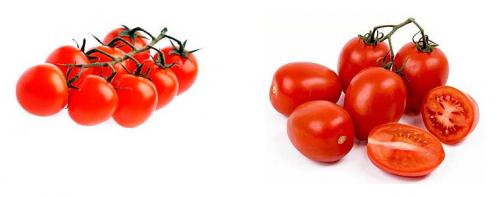

The many beneficial qualities that tomatoes have have made these vegetables one of the most popular foods available to mankind. For example, Italians consider tomatoes to be the primary product in the preparation of a huge number of various dishes.
So the world-famous pizza, and no less famous pasta, necessarily include tomatoes as one of the ingredients, which, thanks to their peculiar sour-sweetish taste, perfectly fit into these dishes.
In Asian countries, as well as in southern Europe, tomatoes hold the lead among vegetables and are considered an indispensable ingredient in cooking.
The benefits of tomatoes are not limited to taste alone. Their beneficial properties can be successfully used to treat many ailments.
The benefits of tomatoes are due to their rich composition. Vitamins in them are represented by a whole set of substances necessary for a person: A, C, B1, B2, B6, E and PP. Of their mineral composition, iron, sodium, zinc, manganese, magnesium, iodine should be noted. They also contain fructose, glucose and lycopene.
Lycopene is a unique ingredient that can effectively fight a number of diseases.In addition, tomatoes contain a lot of malic and citric acids, which are necessary for the normal course of metabolic processes in the body and rid blood vessels of "excess" cholesterol.
Of the many varieties of tomatoes, yellow ones are considered the most valuable for allergy sufferers. This color of tomatoes makes it possible for people with allergies to consume them as much as they want without harming their health. In addition, they are great for children's menus and can be included in diet meals.
It is advisable to use them fresh, for example, in salads or separately, as a dessert. Yellow tomatoes are more fleshy and have a rich sweetish taste. Their juice, which contains little acid, is very useful, and its structure is similar to purified water.
The yellow tomatoes are delicious. They are sweet and have more pulp than red ones. They are rich in organic acids, vitamins. According to some indicators, yellow tomatoes are even ahead of citrus fruits. Traditional healers claim that yellow and orange tomatoes are the most valuable in terms of medicinal properties. This food can heal the body. It is useful for the kidneys, liver, intestines, helps to get rid of accumulated toxins and toxins, which can often cause allergies.
What to choose for salting
Pickling and canning tomatoes should be medium in size to fit into the jar. All kinds of cream and elongated tomatoes are well suited for pickling. Cherries can be canned directly with brushes.
In addition, pickled tomatoes should have a firm flesh and a strong skin that is not prone to cracking.
- Long fruit varieties: Banana Legs, Agafia, Kesidi's Quirk, Scarlet Candles, Auria, Benito, Cheerful Dwarf.
- Oval compact tomatoes: Amulet, Canned, De Barao, Dusya, Hedgehog, Salted miracle.
- Tomatoes with small round fruits: Amur tiger, Asvon, Spring round dance, Blagovest, Boni-MM, Lemon boy.
- Pear-shaped tomatoes: Anna German, Wine jug, Red and pink pear.
Tomato fruits or vegetables. Tomato: is it a berry, a vegetable or a fruit?
Tomatoes are a fairly widespread plant, therefore, in different countries and cultures, questions have often arisen as to whether its fruits, tomatoes, are a vegetable, fruit or berry.
Why tomatoes are considered a berry
Let's try to find out if a tomato is a berry or a vegetable.
A berry is the fruit of a herbaceous or shrub plant that has juicy pulp and seeds inside. The tomato fully meets this definition, being the fruit of a herbaceous plant with a thin skin, juicy pulp and a large number of seeds inside. It is also interesting to read about such berries as yoshta, dogwood, blueberries, viburnum, ezhemalina, barberry, blueberries, chokeberry, gooseberries, juniper, princess, cloudberries and blackberries. Berry fruits are divided into the following types:
- Berry (these include tomato, blueberry, blueberry, currant, gooseberry)
- Apple (these are apples, pears, mountain ash)
- Orange (citrus - orange, tangerine)
- Pomegranate (this is the fruit of the pomegranate)
- Pumpkin (this type includes watermelon, melon, zucchini, pumpkin)
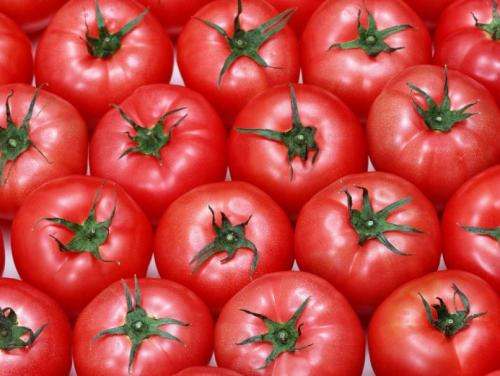

In addition, berries are divided into real and false. A distinctive feature of a real berry from the point of view of botany is the finding of seeds inside the pericarp. It is worth noting that the tomato corresponds to this feature as well. This means that you can positively answer the question of whether a tomato is a berry.
Did you know? Berries that are familiar in our understanding, for example, strawberries or strawberries, are false berries, since the seeds are outside of them. Also, raspberries, blackberries do not belong to berries in botany at all, their fruits are polydrupes.
Tomato - vegetable
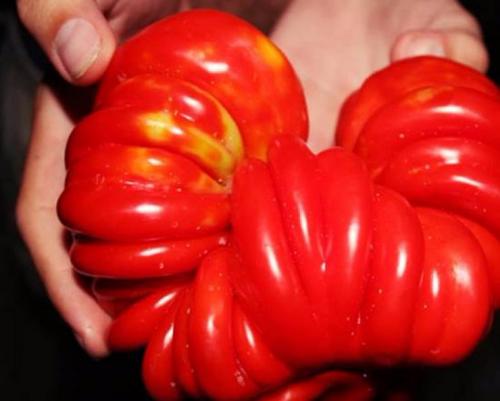

Technological taxonomy explains that tomato is a vegetable based on the cultivation method similar to other vegetables.This is an annual crop, and tomatoes are harvested as a result of tillage and loosening of the soil, which takes a short time. Vegetables such as carrots, cucumbers, garlic, onions, chili peppers, cabbage, okra, zucchini, squash and lagenaria are some of the main sources of vitamins. From a culinary point of view, tomato fruits are also referred to as vegetables according to the method of processing and eating. Most often, they are combined with fish and meat, and are also used independently in appetizers, first and second courses, and not in desserts.
All this makes it possible to call a tomato a vegetable.
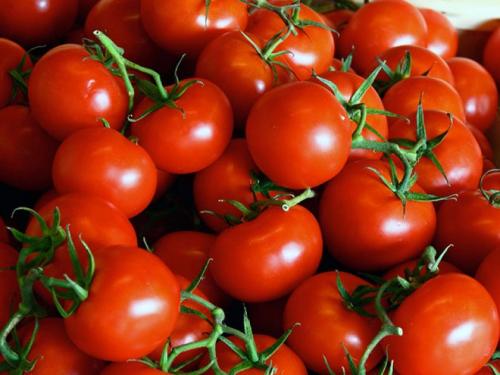

Important! Tomato fruit can be called a natural antidepressant. The tomato contains the mood-boosting hormone of happiness - serotonin, as well as tyramine, which is converted into serotonin in the body.
Why tomatoes were called fruits
Due to the shape, color, juiciness of the tomato, questions arise whether it is a fruit or a vegetable.
The definition of "fruit" describes it as the hard or soft part of the plant in the form of a fruit with seeds. The fruit is formed as a result of the pollination of the flower from the ovary. The vegetable is the overgrown herbaceous or root system of the plant. From this it follows that all the fruits of plants with seeds can be called fruits, which is why a tomato is often called a fruit.
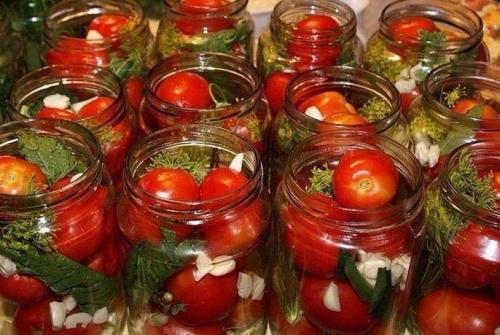

There is also a scientific description according to which fruit is the edible reproductive part of a plant with seeds, which develops from the ovary of a flower. However, tomatoes are used in cooking as vegetables. Therefore, it is so difficult to find out who the tomato is a vegetable or not.
Did you know? Tomatoes contain lycopene - a substance that slows down the aging of body cells, protecting it from harmful effects. Lycopene is not destroyed by heat treatment.
Frost-resistant varieties
Most varieties of Siberian selection are resistant to low temperatures. This allows you to get a good harvest in regions of risky farming, as well as plant seedlings early and collect fruits.
Seeds and seedlings are additionally hardened to achieve even greater frost resistance.
Tatiana Orlova (Candidate of Agricultural Sciences):
There are no frost-resistant varieties of tomato. Tomato is a southern heat-loving plant. His homeland is Central and South America. For 200 years of growing it in culture, none of the breeders has been able to get really frost-resistant varieties. There are relatively cold-resistant varieties. Tomato dies after a long stay at a temperature of +10 degrees. At -1 degrees Celsius, the tomato dies within a few hours. And cold-resistant varieties can stay at a temperature of + 10-12 degrees for up to 7-10 days without irreversible consequences and death for themselves.
Gina
A short or medium-sized tomato for open ground. Tomatoes are medium in size (150 to 300 g). Ripening period is early.
The taste of the fruit is classic, with a pronounced tomato aroma. Resistant to cold snaps and other weather changes.
Nastenka
An early variety with vigorous seedlings and undersized bushes. Fruits are oval, raspberry-red in color, weighing 150-200 g.
Tomatoes taste good and are versatile in use (suitable for salads and canning). Another advantage is resistance to late blight.
Siberian
Cold-resistant hybrid of late ripening. Differs in large and sweet fruits. (Fixed frost-resistant - to cold-resistant, because tomato is a plant of warm subtropics and today there are NO FROST-RESISTANT TOMATOES, tomato dies at t O C. At a temperature of +10 degrees, all physiological processes in the plant stop and a long stay at this temperature - 15 -20 days - leads to irreversible processes and his death).
Tomatoes weight - from 400 to 700 g. Bushes grow tall - they need shaping and garter.
Polar explorer
An early ripe variety that can be grown not only by seedlings, but also by direct sowing of seeds.
The bushes grow up to 100-120 cm and need partial pinching.Tomatoes - medium size (100-150 g), classic taste and good keeping quality.
How to determine the right variety
In our country alone, about 500 varieties and hybrids have been bred, many of which can be bought in shops for gardeners and from individuals.
It is extremely important to learn to understand which tomatoes are right for your region with its climatic conditions: early or late spring, hot and dry or, conversely, cold summer, and maybe early August frosts. You also need to understand which varieties are more suitable for greenhouse conditions, and which ones for open ground.
Fundamental rules
To achieve high performance and good results from your tomatoes, there is only one algorithm of actions: to plant varieties that are well known to you on seedlings and, plus, several new breeding products to test them.
It must be understood that for each gardener, the best variety is the one that suits him specifically.
- If you sell tomatoes, you need large, firm-skinned fruits that keep well (they tolerate transportation well).
- If you prefer to grow tomatoes exclusively for pickling, you need medium-sized tomatoes with thin skins that are well salted.
But for absolutely everyone it is important that the culture grows well, does not get sick and has a high yield.
In addition to knowing your preferences and climatic conditions, you also need to be able to properly grow seedlings from seeds. The future harvest depends on the quality of the planting material.
():
For commercial production, it is currently preferable to use not varieties, but hybrid tomato plants. Their seeds are much more expensive, but worth it. In the first generation, such hybrid tomato plants give a “burst” of yield. Typically, hybrid tomato plants have increased immunity to major diseases.
And we must not forget about proper care! Any hybrid resistant to adverse conditions and diseases still requires appropriate attention. Only the optimal combination of all these components will allow you to achieve high yields from your tomatoes, regardless of where they grow, in Siberia or the Urals.
Reviews of gardeners
Farmers and gardeners prefer to buy seeds from trusted producers and reputable collectors.
Popular agricultural firms include Gavrish, Aelita, SeDek, Semko Junior. Seeds from Myazina, Kondzasova, Medvedev, Gusev, Popenko receive a lot of positive feedback.
Gardeners recommend annually supplementing the tested varieties on the site with several new ones, in order to then compare them and choose the best.
It is very useful to keep relevant records, noting important points in the diary (name of the variety, planting day, diseases, yield, etc.).
Analyzing the achieved results and actively following the new products, it is not difficult to create your own collection of the best, delicious and fruitful tomatoes.
The economic aspect of the tomato controversy
In English, there is no difference between the words "fruit" and "fruit". The importance of determining the belonging of tomatoes to any group arose with the need to obtain customs duties on these products when crossing the border.
The first controversy over tomatoes originated in America. In 1893, the US Supreme Court ruled that fruits should be considered vegetables according to the way they were used, and customs duties should be levied on them as if they were vegetables. Customs duties were not charged on fruits.
In Europe in 2001 the same question arose again, but this time the tomato was recognized as a fruit, again for commercial reasons. The duty on fruits is higher than on vegetables.

